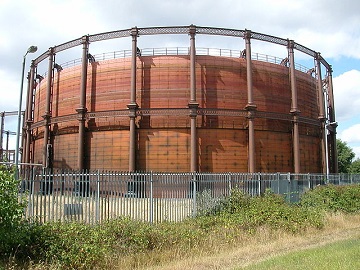Synthetic natural gas

Synthetic natural gas is a type of gas created from coal that serves as a substitute for natural gas and is suitable for transmission in natural gas pipelines. This natural gas substitute must have a minimum of 95% methane in it.[2] An intermediate step in the process of creating synthetic natural gas is the production of synthesis gas, also known as syngas.
Natural gas is a major component of the world's energy supply, as it is used widely in residential, commercial, and industrial applications. However, the supply is limited and thus synthetic natural gas is desireable where there is an absence or shortage of natural gas in a region. This type of natural gas is desireable as it has combustion characteristics similar to natural gas, and because of this minimal changes need to be made to use synthetic natural gas.[3]
Production
Synthetic natural gas is created through a thermo-chemical conversion. The first step in this conversion is the gasification of the solid carbon source, whether it be coal or biomass (which would create Bio-SNG), with steam or oxygen.[4] Here the coal is burned with a limited supply of oxygen or air and the main product is carbon dioxide:[5]
To reduce the amount of nitrogen in this gas, modern gas plants use pure oxygen for combustion. If steam is added to this pure oxygen then a water gas reaction occurs instead of the traditional combustion:[5]
These processes drive off some of the volatile material, and the product is known as a producer gas. Generally, this occurs in a gasifier which feeds coal into a high pressure, high temperature vessel and distributes steam or oxygen evenly while removing ash to gasify the coal.[5] This producer gas is a mixture containing H2, CO, CO2, H2O, and CH4 along with other hydrocarbons and some impurities. The exact composition of this gas depends on the type of reactor used, operating conditions, and other processes during the gasification process.[4] This gas also contains impurities such as oils, tars, hydrogen sulfide, and ammonia which must be removed - although ammonia levels are lower if the water gas reaction takes place.[5]
To purify this gas, it must undergo gas cleaning and gas conditioning. During gas cleaning, impurities such as ammonia and sulfur are removed from the producer gas whereas in gas conditioning is the process by which parts of the producer gas are converted so that the final composition of the gas is suitable for its use.[4] What is left after this cleaning and conditioning is useful synthesis gas (carbon monoxide and hydrogen) plus some methane, and carbon dioxide.[5]
To finish making the synthetic natural gas, the syngas must undergo water gas shift reactions and methanation. The water gas shift reaction combines carbon monoxide with steam to create carbon dioxide and hydrogen in the following reaction:[5]
This reaction requires a metal catalyst to occur. Since the end "goal" of this gas is to obtain methane (the main component of natural gas) some of the carbon monoxide is retained, so the reaction does not go through to completion. At this point, the carbon dioxide is separated out using a type of scrubbing and only the final methanation step remains. During methanation, carbon monoxide reacts with the hydrogen that was created with the help of a nickel catalyst to create methane and steam in the following reaction:[5]
At this point, the synthetic natural gas is complete after half of the original carbon in the coal has turned into methane. The rest of the carbon is turned into carbon dioxide.
Bio-SNG
Bio-SNG is produced similarly to regular synthetic natural gas, but is instead made through the gasification of biomass. Biomass such as forestry residues or energy crops are used. To make Bio-SNG, biomass is initially dried and goes through initial gasification. After this, it undergoes gas conditioning, SNG synthesis, and finally gas upgrading.[6]
References
- ↑ Wikimedia Commons. (May 26, 2015). Gasometer [Online]. Available: http://en.wikipedia.org/wiki/Coal_gasification#/media/File:Gasometer_in_East_London.jpg
- ↑ L.Albright, L.Angenent, F.Vanek. (May 22, 2015). Energy Systems Engineering: Evaluation and Implementation, 2nd ed. New York, U.S.A.: McGraw Hill, 2012, pp. 148
- ↑ National Gas. (May 22, 2015). Synthetic Natura; Gas [Online]. Available: http://www.nationalgasco.net/OurBusiness/SyntheticNaturalGas.aspx
- ↑ 4.0 4.1 4.2 S. Biollaz, T. Schildhauer, J.Kopyscinski. (May 26, 2015). Production of synthetic natural gas (SNG) from coal and dry biomass – A technology review from 1950 to 2009 [Online]. Fuel. August 2010, vol 89, pp.1763–1783
- ↑ 5.0 5.1 5.2 5.3 5.4 5.5 5.6 G.Boyle, B.Everett, S.Peake, J.Ramage. (May 26, 2015). Energy Systems and Sustainability: Power for a Sustainable Future, 2nd Ed. Oxford, UK: Oxford University Press, 2012.
- ↑ European Biofuels. (May 22, 2015). Bio-SNG [Online]. Available: http://biofuelstp.eu/bio-sng.html

